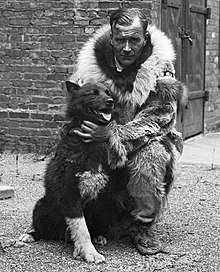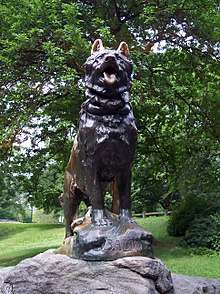Balto
Balto (1919 – March 14, 1933) was a Siberian Husky and sled dog who led his team on the final leg of the 1925 serum run to Nome, in which diphtheria antitoxin was transported from Anchorage, Alaska, to Nenana, Alaska, by train and then to Nome by dog sled to combat an outbreak of the disease.[1]
 Balto with his musher, Gunnar Kaasen | |
| Species | Dog |
|---|---|
| Breed | Siberian Husky |
| Sex | Male |
| Born | 1919 Nome, Territory of Alaska |
| Died | March 14, 1933 (aged 14) Cleveland, Ohio, United States |
| Resting place | Cleveland Museum of Natural History |
| Nation from | American |
| Occupation | Sled dog |
| Known for | 1925 serum run to Nome |
| Appearance | Black with white "socks", "bib", and partial white markings on belly and tip of the muzzle, which advanced with age (including white markings around the eyes when he was old). Eyes were dark brown. |
| Named after | Samuel Balto |
Balto lived in ease at the Cleveland Zoo until his death on March 14, 1933, at the age of 14. After he died, his body was mounted and displayed in the Cleveland Museum of Natural History, where it remains today.
Despite Balto being given more attention at first by news reporters and filmmakers, the longest and most hazardous stretch of the run was actually covered by his owner, Leonhard Seppala, and his dog team, led by Togo. [2]
1925 serum run
In January 1925 doctors realized that a potentially deadly diphtheria epidemic was poised to sweep through Nome's young people. The only serum that could stop the outbreak was in Anchorage, Alaska. The engine of the only aircraft that could quickly deliver the medicine was frozen and would not start. After considering all of the alternatives, officials decided to move the medicine via multiple dog sled teams. The serum was transported by train from Anchorage to Nenana, where the first musher embarked as part of a relay aimed at delivering the serum to Nome. More than 20 mushers took part, facing a blizzard with -23 °F (−31 °C) temperatures and strong winds. News coverage of the event was worldwide.
On February 2, 1925, the Norwegian Gunnar Kaasen drove his team, led by Balto, into Nome. The longest and most hazardous stretch of the run was actually covered by another Norwegian, Leonhard Seppala, and his dog team, led by Togo. They came from Nome towards the end of the run and picked up the serum from musher Henry Ivanoff. The serum was later passed to Kaasen.
Balto proved himself on the Iditarod trail, saving his team in the Topkok River. Balto was also able to stay on the trail in near whiteout conditions; Kaasen stated he could barely see his hand in front of his face. Balto's team did their leg of the run almost entirely in the dark. The final team and its sledder were asleep when Balto and Kaasen made it to the final stop, so Kaasen decided to continue on. At Nome, everybody wanted to thank Kaasen at first, but he suggested giving praise to Balto as well.
Aftermath

After the mission's success, Balto and Kaasen became celebrities. A statue of Balto, sculpted by Frederick Roth, was erected in New York City's Central Park on December 17, 1925, ten months after Balto's arrival in Nome. Balto himself was present for the monument's unveiling.[3] The statue is located on the main path leading north from the Tisch Children's Zoo.[4] In front of the statue a low-relief slate plaque depicts Balto's sled team, and bears the following inscription:
Dedicated to the indomitable spirit of the sled dogs that relayed antitoxin six hundred miles over rough ice, across treacherous waters, through Arctic blizzards from Nenana to the relief of stricken Nome in the Winter of 1925.
Endurance · Fidelity · Intelligence[4][5]
Balto could not be used for breeding because he was neutered at a young age, so he was relegated to the vaudeville circuit along with his team. When Kaasen wished to return home to Alaska, his dogs were sold to the highest bidder by the company who sponsored his tour. The dogs ended up chained in a small area in a novelty museum and freak show in Los Angeles.
While visiting Los Angeles, George Kimble, a former prize fighter turned businessman from Cleveland, was shocked to discover the dogs were unhealthy and badly treated. Mr. Kimble worked together with the newspaper The Plain Dealer to bring Balto and his team to Cleveland, Ohio. On March 19, 1927, Balto and six companions were brought to Cleveland and given a hero's welcome in a triumphant parade. The dogs were then taken to the Brookside Zoo (now the Cleveland Metroparks Zoo).
After Balto died in 1933, his remains were mounted by a taxidermist, and donated to the Cleveland Museum of Natural History.[6] In 1965 Carl Barks introduced a hero dog named "Barko" as a character in an Uncle Scrooge comic book, North of the Yukon, as an homage to Balto. In 1998 the Alaska Legislature passed HJR 62- 'Bring Back Balto' resolution. The Cleveland Museum of Natural History declined to return Balto; however, in October 1998, Balto left for a five-month stay at the Anchorage Museum of History and Art which drew record crowds. Balto was part of another exhibit at the Anchorage Museum of History and Art in 2017.[7]
Alistair MacLean's 1959 novel Night Without End includes a sled dog named Balto, fictional descendant and namesake of the original Balto. In January 1977, Margaret Davidson wrote Balto: The Dog Who Saved Nome[8], a children's book containing a telling of Balto's deeds. Then, in December 1995, Balto, a live action and animated movie, was made, loosely depicting Balto's journey. This film portrays him as a brown-and-grey wolfdog (as the book also portrays him as a wolfdog, but still portrays him as a "big, black dog", as he truly was), who is voiced by Kevin Bacon.
See also
References
- Salisbury, Gay; Laney Salisbury (2003). The Cruelest Miles: The Heroic Story of Dogs and Men in a Race against an Epidemic. New York: W.W. Norton & Company. pp. 187. ISBN 0-393-01962-4.
- "Disney's Togo vs. the True Story of the 1925 Serum Run to Nome". History vs. Hollywood. Retrieved 25 March 2020.
- "Central Park Monuments - Balto". New York City Department of Parks & Recreation. Retrieved February 20, 2017.
- "Balto". Central Park Conservancy. Retrieved February 20, 2017.
- "Balto, (sculpture)". Save Outdoor Sculpture, New York New York survey. June 1993. Retrieved February 7, 2012.
- "Balto". Encyclopedia of Cleveland History. Case Western Reserve University. March 27, 1998. Retrieved June 26, 2008.
- DeMarco, Laura (February 13, 2017). "Cleveland's most famous canine, Balto, to visit Alaska". The Plain Dealer. Cleveland, Ohio. Retrieved February 20, 2017.
- Balto: The Dog Who Saved Nome, retrieved 2020-01-24
External links
| Wikimedia Commons has media related to Balto. |
| Wikiquote has quotations related to: Balto |